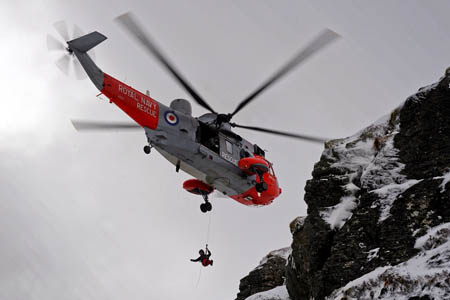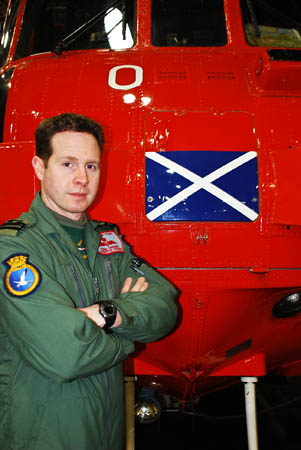The crew of a Royal Navy rescue helicopter described a hair-raising flight in a blizzard in which they plucked an injured walker from a Highland munro.
The pilot and his colleagues from HMS Gannet in Ayrshire had to guide the aircraft to the stricken walker on Beinn Sgulaird in total darkness and swirling blizzards.
Lieutenant Commander Craig Sweeney who was piloting the Sea King said conditions were among the worst they had encountered this year.
The crew was carrying out routine training when the alert came at 4pm on Sunday to go to the aid of the walker who was near the summit of the 937m (3,074ft) mountain, which lies between Glen Creran and Glen Etive.
Lt Cdr Sweeney said: “It was very dark and very cold. The cloud base was at around 1,000ft when we arrived and it really did look doubtful as to whether we would be able to fly up the mountain at all.
“However, what was also clear was that the casualty had a serious ankle injury of some kind and was not going to be able to walk down the mountain.
“Taking that into account and the harsh wintry conditions, and the fact that in such low temperatures every minute can make a huge difference to survival, we set to work to try and get through.
“We collected three members of Oban Mountain Rescue Team and began a slow hover-taxi up the mountain.
“Above 1,500ft we were into cloud and recirculating snow, which made for extremely delicate flying; essentially our only visual references came from the mountain itself.
“And in order to see this reference which would allow me and the crew to ascend safely, we had to go extremely close to the rock face throughout the whole journey up the mountain – that’s how bad the visibility was.
“All around us was nothing but swirling snow and we were very close to whiteout conditions. Essentially, as a pilot I could see nothing.
“And a rock face is a pretty formidable hazard. Coupled with the snow and swirling cloud whipped up by the downwash from the rotors, it made the conditions exceptionally challenging.
“It was intense flying which relied on dozens of years of the whole crew’s experience and expertise, and really full-on team work.
“I have trained and worked with Chief Petty Officer Jason Bibby, my winchman, all around the world and, more notably, have practised this very technique both in the arctic conditions of Norway and the desert sands of Afghanistan, where you get a very similar thing happening when the rotors kick up the fine sand particles.
“And it all led to us being able to get the job done safely and as quickly as possible in some of the worst conditions we have experienced this year.
“It was a long, slow process and it paid off when we got just below the summit where we found the walker.
“He had had the forethought to shine a torch, which we were just able to make out, and together I and my co-pilot Lieutenant Mark Wielopolski managed to get the helicopter into a position where we could set down the three members of mountain rescue team and our aircrewman.
“Conditions underfoot for the rescuers were absolutely treacherous and it was also extremely steep at that point.
“Our winchman Jason is also a qualified paramedic and was able to make immediate on-site assessment of the casualty.
“It appears he had slipped and hurt his leg, and had been lucky enough to fall in an area where he had enough mobile coverage to raise the alarm.
“The casualty had managed to keep himself warm in a bivvy bag, so he wasn’t suffering too badly from the cold. But I think he was pretty pleased and relieved to see Jason, the MRT guys and our helicopter.”
The Royal Navy crew flew the rescuers down to the base of the mountain before delivering the casualty to Belford Hospital in Fort William, where they arrived with just five minutes’ fuel left.
After refuelling at Corpach the aircraft headed back south, but was called into action again when it got a message two walkers were in difficulties on Aonach Eagach above Glencoe.
The pair were stranded at the eastern end of the ridge, near Meall Dearg.
Lt Cdr Craig Sweeney and Lieutenant Mark Wielopolski and fellow crew members observer Lieutenant Phil Gamble and aircrewman-paramedic Chief Petty Officer Jason Bibby flew to the site and at one point had to make an emergency manoeuvre to avoid crashing the aircraft.
Lt Cdr Sweeney said: “Again, conditions were pretty bad, though we did have more visibility than in the previous job.
“On our first attempt we made it to the rough vicinity of the walkers, but the fresh snow soon engulfed the aircraft and I was forced to conduct an emergency breakaway from the ground. The visibility had become very poor, we couldn’t see much at all – it looked like the surface of the moon.
“We tried again and this time Jason was able to see flashing lights, so finally we knew exactly where they were. However, we were not in a position to be able to land and were forced back once more.
“Our third attempt was even worse, and we were just engulfed once more by cloud and snow.
“What we had been able to do by then was let Glencoe Mountain Rescue have a very accurate indication of where the two climbers were, which helped them.
“As we were considering our fourth attempt to get to the casualties, we heard that the mountain rescue team was only 10 minutes from the scene and would report back to us about the status when they arrived with the stricken climbers.
“As it happened, it was very good news all round – the details which came back were that the two were safe and well – they had got disorientated in the snow and cloud and didn’t know which way to go.
“Aside from being cold and rather scared, they were absolutely fine and were actually able to walk down the mountain themselves with the expert guidance of the mountain rescue team.”
The crew arrived back at its Prestwick base at 9.25pm after 5¼ hours’ flying in extreme conditions.
The full crew returned to both mountains today to view the rescue locations in daylight and more clement conditions.


peter stuart
20 December 2011Send him an invoice for the cost of rescue
rob thom
20 December 2011wait till you need help one day peter and they send you the bill. great job to those guys do to help members of the public put there lives at risk for every person they save from the hills. you cant help if you get hurt by accident. as for navigation get a gps for back up??
Martyn Pawson
20 December 2011"Contractors are to take over helicopter search and rescue roles from the military, the UK government has said.
Ageing Sea King helicopters flown by the RAF and Royal Navy from RAF Lossiemouth in Moray and HMS Gannet in Ayrshire are to be retired by 2016."
The job will be done by the cheapest company the politicians can find,on behalf of the Coastguard.
Will a private company have the crews with the experience of the military, and be allowed / able, to fly to the minima of the RN and RAF ?
Link... https://www.facebook.com/#!/group.php?gid=295481233596
simon geering
21 December 2011This shows just why we must fight to keep UK SAR in the hands of the Navy & RAF, there is no way some PMC will perform this sort of rescue work to the same level !
Margaret
21 December 2011Skill and professionalism is a given - but as I wrote in a previous post - a valuable 'visual presence' of our military services will be lost with privatisation.
colin
21 December 2011A bigger problem will be health and safety. Do you think civilians will carry out rescues like the above. I think not. They will do what the fire chiefs did early in the year when they refused to let the men go down a well and rescue a poor lady that later died when she would have been saved had they ignored there extreme health and safety directives.
In the future, should you be unfortunate as to have an accident on the hills, no matter how well prepared and experienced you are, pray for it to be a fair weather day.
Sorry for the cynisism